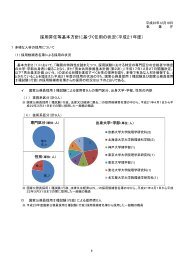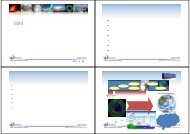Chapter 5 Measurement of Atmospheric Pressure
Chapter 5 Measurement of Atmospheric Pressure
Chapter 5 Measurement of Atmospheric Pressure
Create successful ePaper yourself
Turn your PDF publications into a flip-book with our unique Google optimized e-Paper software.
arometers and the mercury barometer appears to be defective, repair it following the instructionsas described below (See Figure 5.2).1) The difference increase is probably caused by the impaired vacuum or the loose mounting <strong>of</strong>the ivory pointer. When the vacuum becomes impaired, drain and refill the mercury. Whenthe ivory pointer mounting part becomes loose, disassemble and screw it up tightly.2) When the knob (5) used to move the vernier (3) comes loose and causes a large backlash whenthe graduation is adjusted, tighten two nuts on the knob with a special tool (pin face wrench)(6).3) Do not lubricate the adjusting screw (18) and the knob (5) excessively. Excess oil will spreadand melt paint varnish, causing sticky thread. It will stiffen the screw all the more. Inaddition, the oil will soak into the wash-leather bag (15) and the wooden part, and contaminatethe mercury. When the adjusting screw (18) is stiff, it is probably because the screw is bentor the thread is dirty. In these cases, replace the screw or remove and clean it with a brushand cloth.4) When the level <strong>of</strong> a mercury barometer seems to be not working correctly due to an earthquake,for example, loosen three screws <strong>of</strong> the vertical axis pivoting link. Check the level andtighten the screws again.5.5.2 Aneroid Instruments5.5.2.1 Aneroid barometerThe aneroid barometer is a very precise instrument, and it cannot be easily disassembled or repairedon site.5.5.2.2 Aneroid barographRepair aneroid barographs according to the repair instructions in <strong>Chapter</strong> 2: <strong>Measurement</strong> <strong>of</strong>temperature. When irregular movements <strong>of</strong> the pen arm are noticeable, repair it as follows (SeeFigure 5.5).1) Pull out the pin (with ring) (9) and the connecting pin. Clean pinholes on the barometercapsule (1), reed (2) and lever (3) with volatile oil or benzine, and remove old oil. Polish theinside <strong>of</strong> the holes with an oil-absorbing toothpick and apply a thin film <strong>of</strong> high-quality clockoil inside the holes before assembly.2) Feel how the pivots rattle with hands. Remove one pivot at a time. Clear out old oil anddust. When the pivot is rusty, polish it evenly with a lathe or oilstone and lubricate it withclock oil, as mentioned above in 1), before assembly.3) The reed (2) must be centered on the crack <strong>of</strong> the lever (3). If not, check the pin and thecrack for distortion, and repair any defective parts before reassembly.4) To repair the clock-driven drum (5), refer to the relevant section in <strong>Chapter</strong> 2: <strong>Measurement</strong> <strong>of</strong>temperature.5.5.3 Electronic BarometerCylindrical resonator and electrostatic capacity barometers mainly consist <strong>of</strong> electric components,and they rarely have mechanical parts. Therefore, it is rarely possible to repair these barometerson site.13






![関東地方の「紅葉の見ごろ予想」[PDF形式:250KB] - 気象庁](https://img.yumpu.com/47747063/1/184x260/pdf250kb-.jpg?quality=85)

![雨に関する各市町村の50年に一度の値一覧[PDF形式:417KB] - 気象庁](https://img.yumpu.com/47450161/1/190x134/50pdf417kb-.jpg?quality=85)
![1か月予報[九州北部地方]解説資料](https://img.yumpu.com/47153516/1/184x260/1.jpg?quality=85)
![職員募集案内パンフレット[PDF形式:約9MB] - 気象庁](https://img.yumpu.com/45714300/1/184x260/pdf9mb-.jpg?quality=85)


![ダウンロードファイル[PDF形式: 約15MB] - 気象庁](https://img.yumpu.com/43657928/1/190x135/pdf-15mb-.jpg?quality=85)


